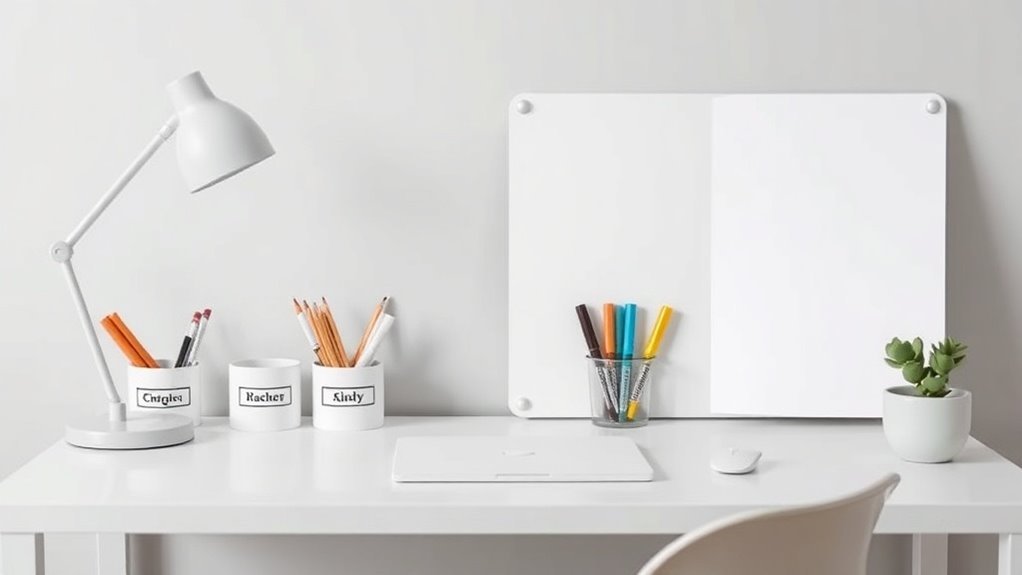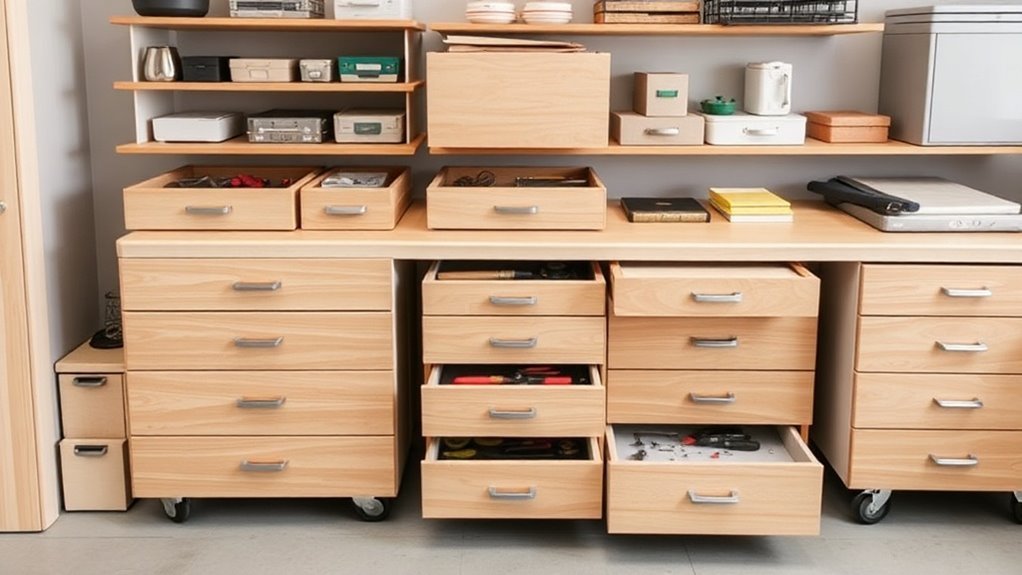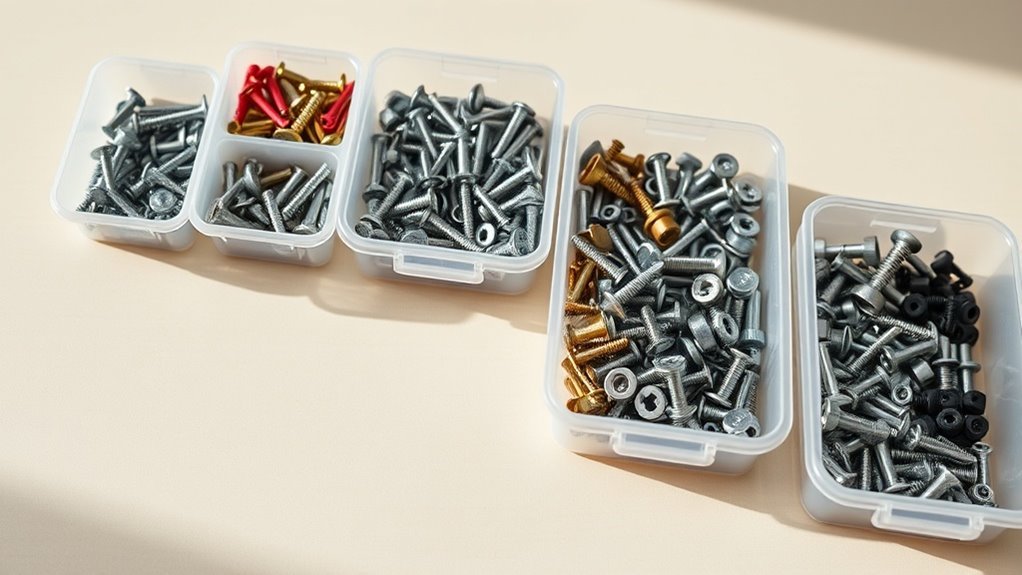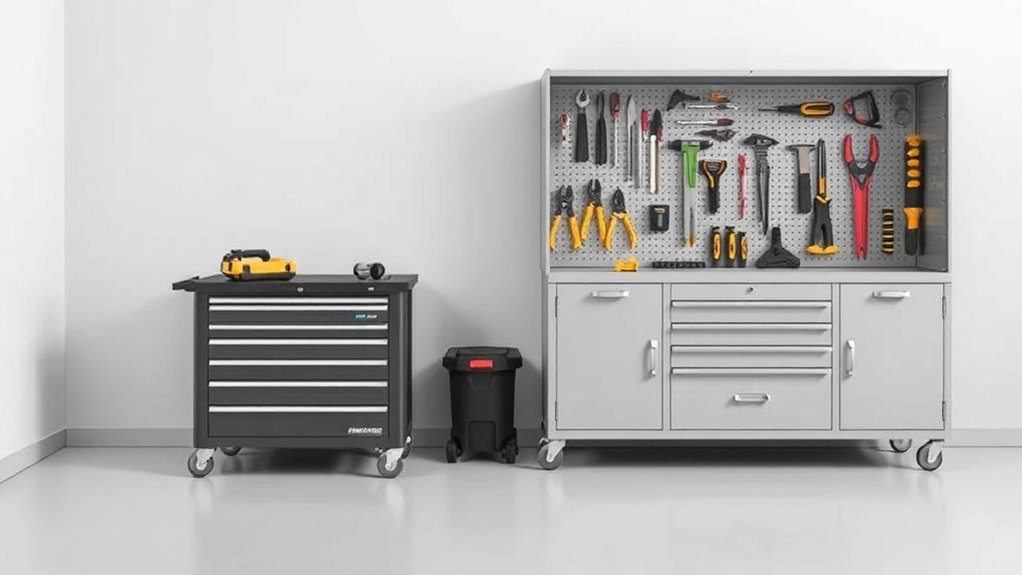Wall-Mounted Storage vs. Floor Storage

When choosing between wall-mounted and floor storage, think about your space and needs. Wall-mounted options save floor area, make rooms feel larger, and keep frequently used items accessible, but they can be tricky to install and limit flexibility. Floor storage is easily accessible, perfect for heavier items, and allows for decor display, but it can create clutter. Consider your room’s layout and your style preferences to find the best fit for you—there’s more to explore on this topic!
Key Takeaways
- Wall-mounted storage maximizes vertical space, while floor storage utilizes horizontal areas, influencing overall room aesthetics and functionality.
- Accessibility is easier with floor storage, as it eliminates the need for ladders or reaching for high-mounted items.
- Wall-mounted options can complicate installation and relocation, whereas floor storage offers more versatility and rearrangement possibilities.
- Wall-mounted solutions can reduce floor clutter and make cleaning simpler, but floor storage may lead to navigation challenges if disorganized.
- Consider the weight of items; floor storage accommodates heavier loads without risk of wall damage or instability.
Advantages of Wall-Mounted Storage
When it comes to maximizing your space, wall-mounted storage offers several distinct advantages.
First off, it frees up valuable floor space, making your room feel larger and more open. By utilizing vertical walls, you can create additional storage without sacrificing walking areas. This is especially useful in small rooms where every inch counts.
Installing wall-mounted storage not only maximizes vertical space but also creates a more open and spacious room.
Wall-mounted options also provide easier accessibility. You can keep frequently used items within reach, categorized neatly, reducing the need to rummage through clutter.
Plus, these systems can be customized to fit your style and needs, from floating shelves to hooks and cabinets. With fewer items on the floor, cleaning becomes a breeze, allowing you to maintain an organized and tidy environment effortlessly. Additionally, utilizing proper storage containers can enhance safety and prolong the life of your tools, ensuring they remain effective when not in use through smart strategies for safe tool storage.
Disadvantages of Wall-Mounted Storage
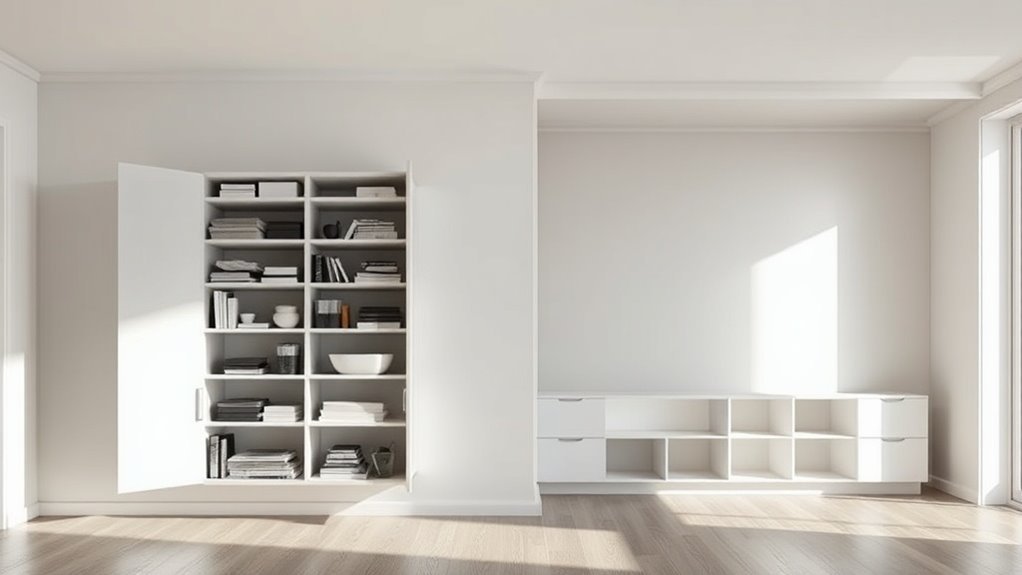
Although wall-mounted storage can enhance your space, it also comes with some notable disadvantages.
First, installation can be a hassle, requiring tools and sometimes professional help, which mightn’t fit your budget.
Second, it may compromise your wall integrity; drilling into walls can lead to damage or costly repairs if not done correctly.
Finally, wall-mounted units often limit flexibility. Once you’ve installed them, moving or rearranging your storage options becomes a challenging task.
- Limited relocation: Once set up, it’s hard to change your mind.
- Potential wall damage: Drilling holes can result in repairs.
- Height restrictions: Items stored high might become unreachable for daily use.
Additionally, effective small parts storage is crucial for maintaining order in your workspace, which can be difficult with wall-mounted options.
Benefits of Floor Storage
Floor storage offers several advantages that can enhance your living space and overall organization.
One major benefit is accessibility; you can easily reach items without the need for a ladder or extra effort. It’s perfect for heavier items, as you won’t have to worry about the weight limits of wall-mounted options.
Floor storage enhances accessibility, allowing effortless reach to heavier items without the constraints of wall-mounted limits.
Additionally, floor storage often provides more versatility, allowing you to rearrange furniture and storage solutions to fit your needs better. It also creates a welcoming environment, making it easier to showcase decor or personal items without the limit of wall space.
Finally, floor storage can help you maximize underutilized areas, turning corners or nooks into functional spaces for your belongings, improving both aesthetic and practicality. Moreover, incorporating modular storage solutions into your floor space can enhance organization, flexibility, and efficiency in your living areas.
Drawbacks of Floor Storage
While floor storage has its benefits, it also comes with several drawbacks that can affect your space.
First, it can take up valuable floor area, making rooms feel cramped or cluttered. This limited space can restrict movement, making it hard to navigate through your home.
Second, floor storage can become a tripping hazard, especially if items are scattered or not organized properly. It’s easy to overlook items on the floor, leading to potential accidents.
Third, it may require more frequent cleaning and maintenance, as dust and debris collect on the items or the floors beneath them.
Evaluating Your Space and Needs
How do you determine the best storage solutions for your home? Start by evaluating your available space and what you need to store. Measure your rooms and consider ceiling height for wall-mounted options; the higher the shelves, the more you can store without taking up valuable floor space.
Next, think about the items you plan to keep. Do you need easy access to everyday items, or can some be tucked away? Understanding your habits will help you choose between wall and floor storage.
Finally, evaluate your style preferences—do you want an open, airy feel or a cozy, contained look? Balancing functionality with aesthetics will guide you to the right storage solution that meets your unique needs. Incorporating efficient storage solutions can significantly enhance your organization and workflow, ensuring that your space remains clutter-free.
Questions
Can Wall-Mounted Storage Accommodate Heavy Items?
Wall-mounted storage can accommodate heavy items, but you’ll need to guarantee it’s securely installed. Check weight limits and consider wall material to prevent damage. It’s crucial to follow manufacturer guidelines for safe usage.
Are There Specific Wall Materials Best for Mounting Storage?
Yes, for mounting storage, materials like plywood, drywall, and concrete work best. Plywood offers strength, drywall’s suitable for lighter loads, and concrete provides excellent support for heavy items, ensuring your storage remains secure and stable.
How Do I Determine the Weight Capacity of Floor Storage?
Like a sturdy oak, your floor storage’s weight capacity relies on the material’s strength and construction. Check manufacturer specifications; consider the flooring type and evenly distribute weight to guarantee lasting support for your items.
What Tools Are Necessary for Installing Wall-Mounted Storage?
You’ll need a stud finder, level, drill, screws, and a screwdriver for installing wall-mounted storage. It’s also helpful to have a measuring tape and a pencil for marking your desired placement. Happy organizing!
How Can I Maximize Storage Efficiency in Small Spaces?
“Less is more,” so declutter and reorganize your space strategically. Use vertical surfaces, multi-functional furniture, and clear containers. Prioritize items you use daily and create designated zones for everything to maximize efficiency in small spaces.
Conclusion
In the battle of wall-mounted storage versus floor storage, the right choice ultimately depends on your space and needs. Wall-mounted options can save precious floor space, making your room feel bigger than the Grand Canyon, while floor storage offers easy access and some serious style. Consider how you use your area and what you want to achieve. With a bit of thought, you can turn clutter into a masterpiece, no matter which storage solution you choose!

